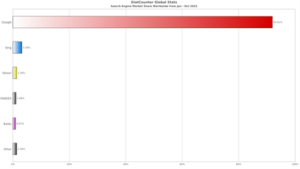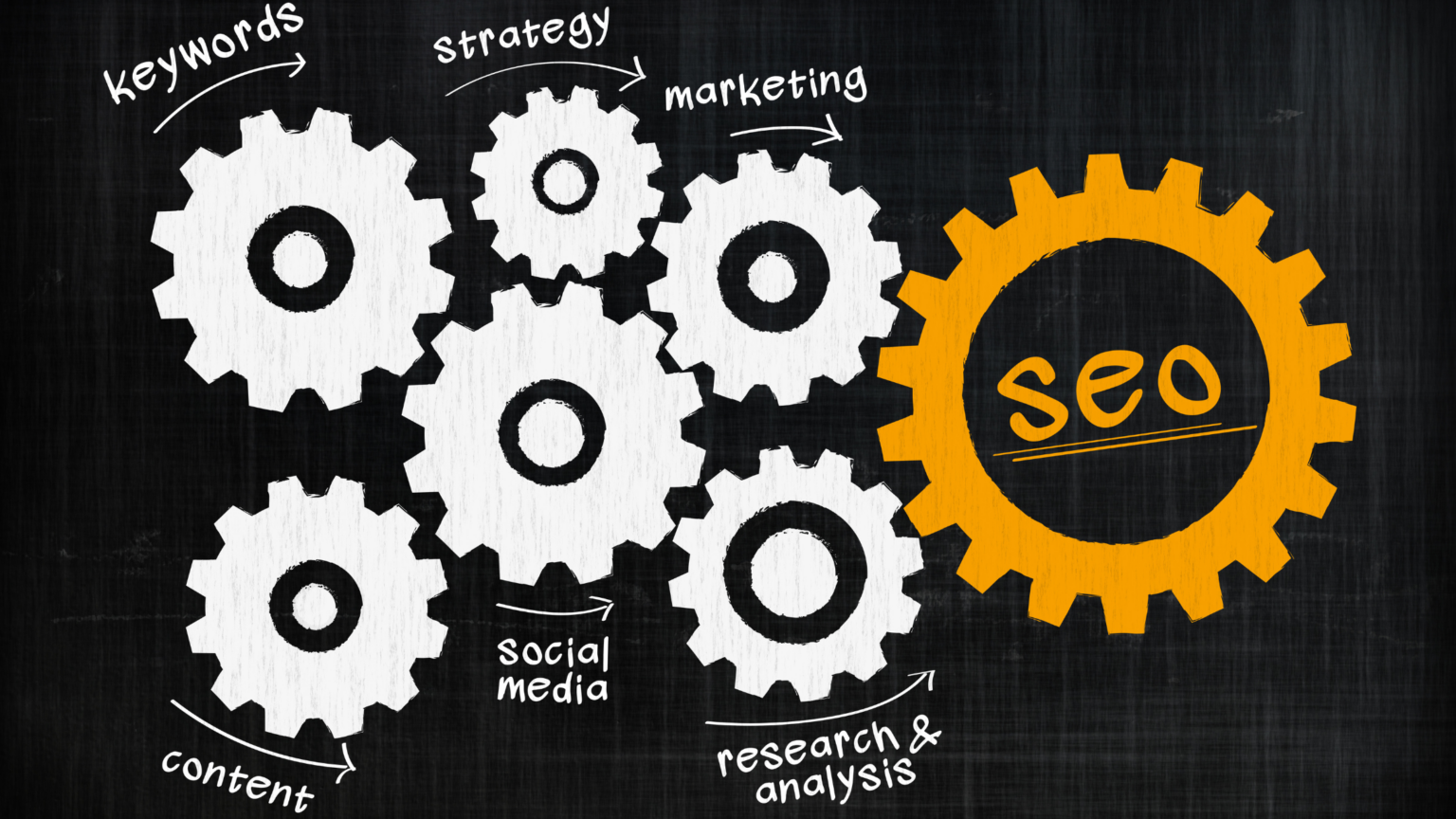A great-looking website with solid and engaging content is only the first step. Your content must be visible if you want people to see it. Search Engine Optimisation, or SEO for short, is essential for every business in today’s digital world. In this month’s blog, Mark Roberts explains how making your business more visible using SEO will generate growth for your business – in traffic, conversions and, ultimately, revenue.
What is SEO?
SEO is the process of optimising your business for higher rankings in Search Engine Result Pages (SERPs). It’s not a one-time thing; it’s an ongoing process that will continue to improve over time as you make changes and develop and add content to your website.
SEO is about attracting the right traffic based on the keywords people are searching for. And converting that traffic into customers—SEO can be extremely valuable for business growth.
The power of Google in the SEO battle
As long as it’s been around, Google has been a powerful tool for finding information and connecting people with their needs. Today Google processes 40,000 searches per second. That means that if you’re not showing up on Page 1, your competitors beat you at the top of the search results and take all your prospective customers with them. Because let’s be honest: who looks past Page 1, or even beyond the first three to five results? It’s estimated that the first five results get as much as 75% of traffic.

The figures from StatCounter for 2022 to the end of October suggest that Google has a massive 92% search engine market share worldwide. With Bing and Yahoo in second and third place. Even the big players in Russia and China – Yandex and Baidu who dominate the markets there, only have around a 1% market share on the worldwide level.
Why is SEO important for your business growth?
Like the algorithms used by Social Media platforms, SERPs use complex algorithms to generate the results of what users type into their preferred search engine. They are made up of technical components and on-the-page and off-page elements. They will look for functionality, high-quality and different types of content that include relevant keywords, the amount of traffic going to your site, and the time people spend on it. Getting these things right will help you rank higher on SERPs.
Most online activity, estimated to be more than 90%, begins with a search engine query. These queries are highly targeted as the user is specifically looking for information. So, if you have a product or service relevant to that query, it is essential to have the content to support it.
Organic versus inorganic
Inorganic (paid-for) results will be contained within an “Ad” box. Companies can pay to appear at the top of SERP within the paid-for results. This method, known as Search Engine Marketing (SEM), should form part of an overall marketing strategy. But a great marketing strategy needs to contain plans for both inorganic and organic results.
Organic search engine optimisation is essential; these organic results appear because they rank highly and are relevant. More and more consumers searching online favour useful, informative content over more direct advertising. So, getting SEO right is a free way of getting to the top of SERP without spending a fortune on advertising.
Technical SEO
The first stage of getting the SEO right is the technical aspects. This is the more complicated part of SEO and would generally be managed by your web designers. But once setup requires much less maintenance and ongoing work than the other aspects of SEO.
Crawl errors
Search engines index pages by “crawling” them. This automated process will quickly scan or “crawl” your page to understand what it’s about. Having errors that stop these “spiders” crawling the page or make the pages difficult to understand or view will prevent it from being indexed and ranked.
Mobile-first
Mobile-friendly websites are important for SEO, user experience, and conversions. Data shows that Mobile and Tablet compared to Desktop use is currently around 60/40. With desktop usage on a slow decline. So, your website must be mobile-optimised – you want your customers to be able to find you on their phones. But more importantly, you want them to be able to easily read and interact with your content when they visit your page.
Broken Links and website speed
Broken links or 404s are a big No – so if you have them, fix them, remove the link or set up redirects. These can be internal links within your website or links to other websites – if they aren’t working, they will hurt your ranking. There are free online tools available to find broken links. It’s also vital that your pages load quickly. Slow-loading pages will impact your SEO ranking and the user experience. Many won’t stay to wait for the content to load, reducing your time on page and adding further detriment to your SEO ranking.
Duplicate Content
Search Engines do not favour duplicate content that is an exact copy or very similar. You must create unique and engaging content and remove anything that is duplicated. And remember, if you remove pages, ensure you have redirects set up, so you aren’t creating broken links!
On page SEO for business growth
This is all about the content on a page and ensuring it is optimised to reach your target audience to help your business grow.
Keywords
This is the first step: research the keywords that relate to your product or service. They should be words actively used when searching for the things you offer customers. But at the same time, looking for those that have low competition. High-competition keywords will be “controlled” by the big players, making it very difficult for you to rank for these. Don’t avoid them entirely if they are relevant to your business but focus on the less competitive but high-volume ones.
It’s also a good idea to have a mixture of both short-tail and long-tail keywords. For example: “Burger Restaurant” (short-tail) and “Best burger restaurant in Cheltenham” (long-tail).
Creating the Content
With your keywords selected, you now need to create the content. It should be informative, accurate and with as much detail and information as possible. Here are some tips for making the keywords rank.
- Title – this should be short (under 60 characters) and must include the keyword, preferably at the beginning.
- URL – make sure the keyword is included in the URL.
- Meta description – this is the text that appears next to your link in the SERP and gives an overview of the page. Make sure it includes your keyword, and it should be under 160 characters.
- Keyword position and density – it’s crucial that your keyword appears in the first paragraph and is repeated in your content (keyword density) every 250-350 words.
- Length and readability – for blog posts, a minimum of 500 words but around 1500 will perform better. Try and use short sentences where you can, of no more than about 20 words.
- Headings – the 1500 words need to be separated and organised using H1, H2 and H3 headings. This will help the reader, but more importantly, search engines, understand what is in the content.
- Using different media types – for example, having downloadable content within a blog or embedded photos and videos. Videos will also help increase users’ time on the page.
- Image tags – when using images, ensure they have alt tags. Not only will this help your marketing content be inclusive, but it will also help spiders when they crawl the page.
- Internal Links – this will help drive traffic to your other pages. Give your website a simple but well-structured framework
- Location – adding your location (if appropriate) to your keyword will help local users when they search.
Off-Page SEO for business growth
You need to work on these things outside your website to help your content rank. Getting these things right can take your SEO to another level to ensure continued growth for your business.
Using social media to promote your content
A detailed and well-planned marketing strategy should include promoting your content across all your social media platforms. You should do this at least once, but don’t be afraid to do this more than once. Just make sure you are changing the messaging in the posts. Sharing on social media will drive traffic to your pages; hopefully, others will also share your posts.
Backlinks
Backlinks are when other websites share your links in their content. They demonstrate to search engines that other websites find your content valuable and accurate. Obviously, the higher the authority of the website that backlinks to your content, the higher the value of your SERP ranking. To benefit from any backlinking, it must be organic (not paid for!). So, this is where using social media to promote your content will increase your chances of websites backlinking to your content.
Don’t be afraid to ask others to share your links. Remember, if you don’t ask…. And what’s the worst that can happen – they say no.
Business Listings
Make sure your business listing is up-to-date and accurate. Google My Business is the most important (given its 92% market share!). But don’t forget Apple Maps and Bing Places. Each listing will need a few basic details:
- Business name
- Location
- Contact details
- Business category
Also, add any additional business categories or additional products/services that you offer. And make your listing stand out by uploading photos.
What good SEO can do for your business.
SEO can help the growth of your business in a number of ways by improving several things:
- Visibility – brand visibility is essential to attract customers. Being on Page 1 at the very least!
- Traffic – being at the top (or at least near it!) on SERP will increase your website visits. Organic search is generally the top source of traffic
- Relevance – organic visitors are looking for precisely what you have. With any paid advertising, there’s no guarantee that your ads reach people who want your product or service.
- Conversions – simple maths, more traffic at the same conversion rate means more business. But with organic traffic, conversion rates are also likely to increase based on the relevance of your solution to their query.
- Credibility – companies with great SEO are more trusted. Others linking to your pages (backlinks) as a source of credible and trustworthy content will build buyers’ trust in you.
- UX – getting the customer experience right means making the website easy to use and increasing the time people spend on your page.
Website optimisation and SEO will attract more visitors, increase sales, grow your customer base and grow your business.
SEO will grow your business
One of the most important elements for business growth is SEO. Content strategy and marketing is the central part of a successful marketing plan. Without it, you’re missing out on customers who might find your competitors. A good SEO strategy with high-ranking pages can bring more traffic than all other marketing efforts at a much cheaper cost.
If you still need to figure out how to optimise your website and content or need help finding out where to start, don’t worry! We’ve got you covered as an all-around marketing agency that can help with SEO digital marketing as part of your overall strategy. We can help you transform your content and develop new content with quantifiable results. Get in touch if you would like to know more about how we can help.

